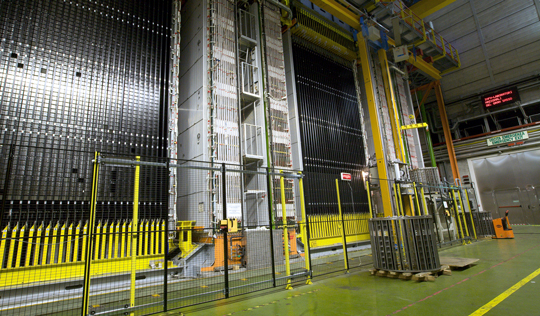 The international programme of the OPERA (Oscillation Project with Emulsion-tRacking Apparatus) experiment announced its final results on 22 May, during a seminar at the INFN National Laboratories of Gran Sasso (LNGS) and in an article published in the scientific magazine Physical Review Letters, as a result of 5 years of observations on neutrinos produced with the CERN Neutrinos to Gran Sasso (CNGS) project, a beam of muon-neutrinos. CNGS was set up to verify the transformation phenomenon of muon-neutrinos and measure the appearance of tau-neutrinos with the OPERA detector, after their 2,4-millisecond journey through the 730 km of the earth’s crust separating CERN from the underground Laboratories of Gran Sasso. The OPERA detector - 4,000 tonnes of mass, made from 150,000 bricks of lead plates and nuclear emulsion sheets to photograph the interactions - observed its first oscillation event of a muon-neutrino into a tau in 2010, followed by four more events detected between 2012 and 2015, when it announced the discovery of the tau-neutrino, having achieved the required statistical significance for the first time. Now, thanks to the application of a new analysis strategy of the entire sample of data, collected between 2008 and 2012 when OPERA was in operation in the Gran Sasso Laboratories, a total of 10 candidate events have been identified, to further improve the level of statistical significance of the discovery: a result that directly and unequivocally demonstrates that muon-neutrinos oscillate into tau-neutrinos. The OPERA programme has made its data public by means of the CERN Open Data Portal. This means that researchers who do not take part in the OPERA programme can also use the data to carry out new research
The international programme of the OPERA (Oscillation Project with Emulsion-tRacking Apparatus) experiment announced its final results on 22 May, during a seminar at the INFN National Laboratories of Gran Sasso (LNGS) and in an article published in the scientific magazine Physical Review Letters, as a result of 5 years of observations on neutrinos produced with the CERN Neutrinos to Gran Sasso (CNGS) project, a beam of muon-neutrinos. CNGS was set up to verify the transformation phenomenon of muon-neutrinos and measure the appearance of tau-neutrinos with the OPERA detector, after their 2,4-millisecond journey through the 730 km of the earth’s crust separating CERN from the underground Laboratories of Gran Sasso. The OPERA detector - 4,000 tonnes of mass, made from 150,000 bricks of lead plates and nuclear emulsion sheets to photograph the interactions - observed its first oscillation event of a muon-neutrino into a tau in 2010, followed by four more events detected between 2012 and 2015, when it announced the discovery of the tau-neutrino, having achieved the required statistical significance for the first time. Now, thanks to the application of a new analysis strategy of the entire sample of data, collected between 2008 and 2012 when OPERA was in operation in the Gran Sasso Laboratories, a total of 10 candidate events have been identified, to further improve the level of statistical significance of the discovery: a result that directly and unequivocally demonstrates that muon-neutrinos oscillate into tau-neutrinos. The OPERA programme has made its data public by means of the CERN Open Data Portal. This means that researchers who do not take part in the OPERA programme can also use the data to carry out new research






